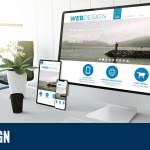In today’s digital age, having an online presence is more important than ever — for businesses, creatives, and individuals alike. That’s why website designing is such a valuable skill. Whether you’re planning to launch a personal blog, a business site, or work as a freelance web designer, understanding the basics of web design will give you a powerful edge. The good news? You don’t need to be a coding expert to get started!
🔑 2. Key Steps in the Website Designing Process
Goal: Break down the full process in simple terms.
Step 1: Planning Your Website
-
Decide on your goal: Is it a business site? Portfolio? Blog?
-
Identify your target audience.
-
Sketch or outline your site’s structure (Home, About, Services, Contact, etc.)
Step 2: Choosing the Right Platform
-
For beginners, platforms like WordPress, Wix, or Squarespace are user-friendly.
-
They provide drag-and-drop functionality and ready-made templates.
Step 3: Designing the Layout
-
Focus on a clean, user-friendly design.
-
Keep navigation simple and consistent.
-
Make sure your design is mobile responsive (looks good on phones and tablets).
Step 4: Selecting Colors, Fonts, and Images
-
Use a consistent color scheme that fits your brand.
-
Choose readable fonts (2 max).
-
Use high-quality images or graphics to enhance visual appeal.
Step 5: Adding Content
-
Write clear, engaging content that speaks to your audience.
-
Include CTAs (Call-to-Actions) like “Contact Us” or “Shop Now.”
-
Break text into sections using headings and bullet points.
Step 6: Testing and Publishing
-
Preview your site on different devices and browsers.
-
Fix any errors or layout issues.
-
When you’re satisfied, hit “Publish”!
Step 7: Maintaining Your Website
-
Regularly update your content.
-
Check for broken links.
-
Improve loading speed and security.
🧰 3. Beginner-Friendly Tools & Frameworks
Suggestions:
-
WordPress (with Elementor): Great for blogs and business websites. Flexible and scalable.
-
Wix: Drag-and-drop interface, ideal for small sites or portfolios.
-
Squarespace: Stylish templates, great for creatives and portfolios.
-
Bootstrap: For beginners who want to learn HTML/CSS with a responsive framework.
-
Canva: For creating design assets like banners or buttons.
💬 4. Final Words: Practice, Learn, Improve
Remember, every expert web designer was once a beginner. Don’t be afraid to experiment, make mistakes, and learn as you go. The key is to keep practicing. Start small — maybe with a personal site — and build your skills from there.
📚 5. Bonus: Helpful Resources to Keep Learning
-
freeCodeCamp.org – Learn HTML, CSS, JavaScript for free
-
W3Schools – Easy-to-understand coding tutorials
-
-
Traversy Media
-
The Net Ninja
-
DesignCourse
-
✅ Optional CTA:
Ready to start your website design journey? Let us know what you’re building — or reach out if you want a beginner-friendly course recommendation!







